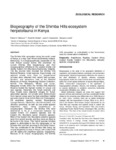| dc.description.abstract | The Shimba Hills ecosystem along the south coast of Kenya is a key East African biodiversity hotspot. Historically, it is biogeographically assignable to the East African coastal biome. We examined the current Shimba Hills herpetofauna and their zoogeographical affinities to the coastal forests and nearby Eastern Arc Mountains biodiversity hotspots. The key studied sites included the Shimba Hills National Reserve, forest reserves, Kaya forests, and adjacent private land. Data on herpetofaunal richness were obtained from recent field surveys, literature, and specimens held at the National Museums of Kenya, Herpetology Section Collection, Nairobi. The Makadara, Mwele, and Longo-Mwagandi forests within the Shimba Hills National Reserve hosted the highest number of unique and rare species. Generally, the forest reserves and Kaya forests were important refuges for forest-associated species. On private land, Mukurumudzi Dam riparian areas were the best amphibian habitat and were host to three IUCN (Red List) Endangered-EN amphibian species, namely, Boulengerula changamwensis, Hyperolius rubrovermiculatus, and Afrixalus sylvaticus,as well as one snake species Elapsoidea nigra. Using herpetofauna as zoogeographic indicators, the Shimba Hills were determined to be at a crossroads between the coastal forests (13 endemic species) and the Eastern Arc Mountains (seven endemic species). Most of the Eastern Arc Mountains endemic species were from recent records, and thus more are likely to be found in the future. This ‘hybrid’ species richness pattern is attributable to the hilly topography of the Shimba Hills and their proximity to the Indian Ocean. This has contributed to the Shimba Hills being the richest herpetofauna area in Kenya, with a total of 89 and 38 reptile and amphibian species, respectively. Because of its unique zoogeography, the Shimba Hills ecosystem is undoubtedly a key biodiversity area for conservation investment. | en_US |

